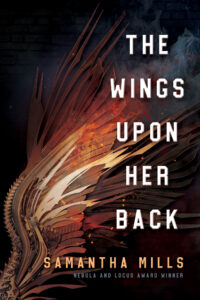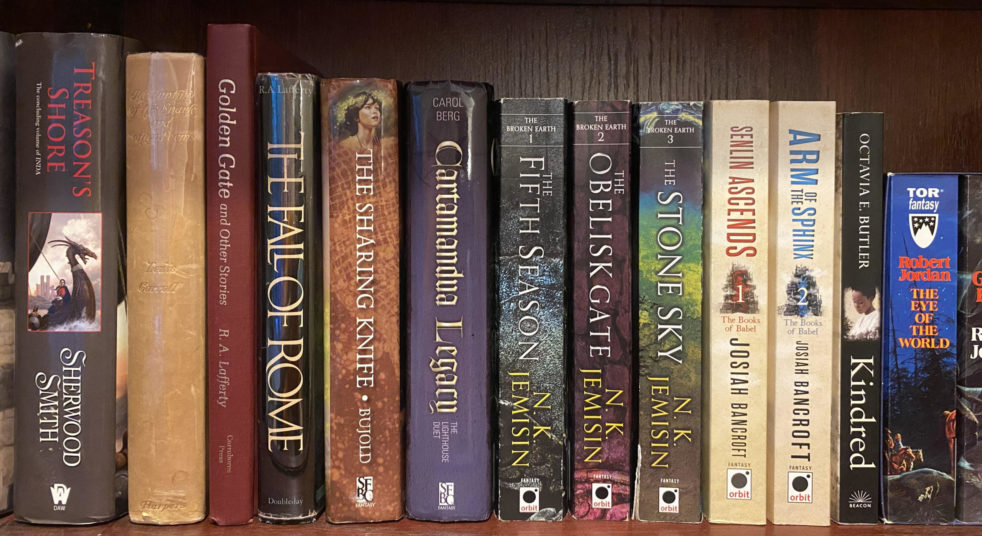
Ever since reading the tremendous “Strange Waters” a few years back, I’ve been eager to get to more of Samantha Mills. So when seemingly half of my Short Fiction Book Club friends were recommending her debut novel The Wings Upon Her Back, it was not a matter of if I would read it, but when.
The Wings Upon Her Back takes place in a world visited bodily by five gods, spawning five different sects dedicated to the trait most beloved by each. By the time of the main events, the gods have retreated to sleep, though they occasionally may be awoken to render judgment in limited cases. The story is told in two timelines, alternating chapter-by-chapter, centering the daughter of a pair of Scholars who dreams of serving as a Warrior and gaining the titular mechanized wings upon her back. The two timelines present two sides of her relationship with the extremely demanding leader of the Warrior sect, first as an acolyte striving to meet the exacting standards of a mentor, then as a disgraced former warrior looking back on everyone that went wrong and trying to do something with the remains of her former life.
Having read this book just three months after another book featuring a zealous teen having her eyes opened to the lies of her insular military sect—the Hugo Award-winning Some Desperate Glory by Emily Tesh—it’s going to be hard for me not to compare the two. I anticipate that most people interested in The Wings Upon Her Back have read Some Desperate Glory, so hopefully those will be helpful comparisons. For those who haven’t, I won’t add spoilers, and I hope this review helps you decide whether one or both may be of interest.
Some Desperate Glory was second on my Hugo ballot almost entirely on the strength of the character study. The lead was genuinely dislikable at the beginning and grew in fits and starts over the course of the novel—a journey that felt remarkably grounded for all the sci-fi chaos in the background. The Wings Upon Her Back doesn’t lean quite so hard into the dislikable lead in the early stages, starting instead with a bright-eyed youth and showing how she turned into a talented soldier nearly as demanding as her mentor. The second timeline also includes changes in fits and starts, making for what feels like a realistic character journey, but a gap of nearly 20 years in between the timelines relegates a good chunk of the character development to off-page implications, and the lead in the second timeline doesn’t quite feel her age.
The Wings Upon Her Back, on the other hand, is much stronger in its portrayal of the antagonist, who is easily the most three-dimensional character apart from the lead. It seems very easy, when writing an abusive villain, to stack various forms of evil on top of each other. Perhaps those evils are hidden—as in Some Desperate Glory—but once they’re discovered, there’s not much question as to whether to strike out in opposition. But in The Wings Upon Her Back, there’s little evil for the sake of evil, or power for the sake of power. Yes, the antagonist has her secrets, and she is power-hungry, but out of a genuine belief that others in power are making mistakes that could have disastrous consequences for the world. Even when she’s transgressing her own moral code, it’s explicable in terms of an eye toward a perception of the good. And when her tough love leadership style burns through recruit after recruit, it’s because she sees herself as forging strong warriors. The result is a nuanced antagonist that makes the lead’s inner struggle genuinely complicated and serves as one of the real strengths of the novel.
Beyond those two major characters, the book mostly just offers plot. The storytelling is fast-paced and plenty readable, but the imagery is fairly sparse, the background worldbuilding clearly isn’t the point, and the secondary characters don’t have nearly the depth of the protagonist and antagonist. This is meant to provide a narrative of joining with and later separating from an abusive leader, with plenty of action along the way. And while that action doesn’t offer much in the way of twists and turns, it does keep the pace moving quickly and provides plenty of danger and plot-related tension. For me, the action isn’t necessarily what makes or breaks a book, but it works well here.
Ultimately, The Wings Upon Her Back is a fast-paced and entertaining novel about joining and later leading a military sect with an abusive leader. For those who have read Some Desperate Glory, I’d say that The Wings Upon Her Back plays it a little safer with the speculative premise but is more daring with the complexity of the antagonist. I don’t think the character study is quite as compelling, but I suspect that fans of Tesh’s novel will enjoy Mills’, which hits many of the same notes and even improves some on of the more controversial elements of Some Desperate Glory. To those who aren’t here for the comparison, I’ll just say this: The Wings Upon Her Back is good.
Recommended if you like: stories about indoctrination, action-packed revolutionary tales.
Can I use it for Bingo? It’s hard mode for Published in 2024, Dreams, Indie Published, and Eldritch Creatures, and it also features Criminals, a Prologue or Epilogue, Reference Materials, and was a Book Club selection.
Overall rating: 16 of Tar Vol’s 20. Four stars on Goodreads.
